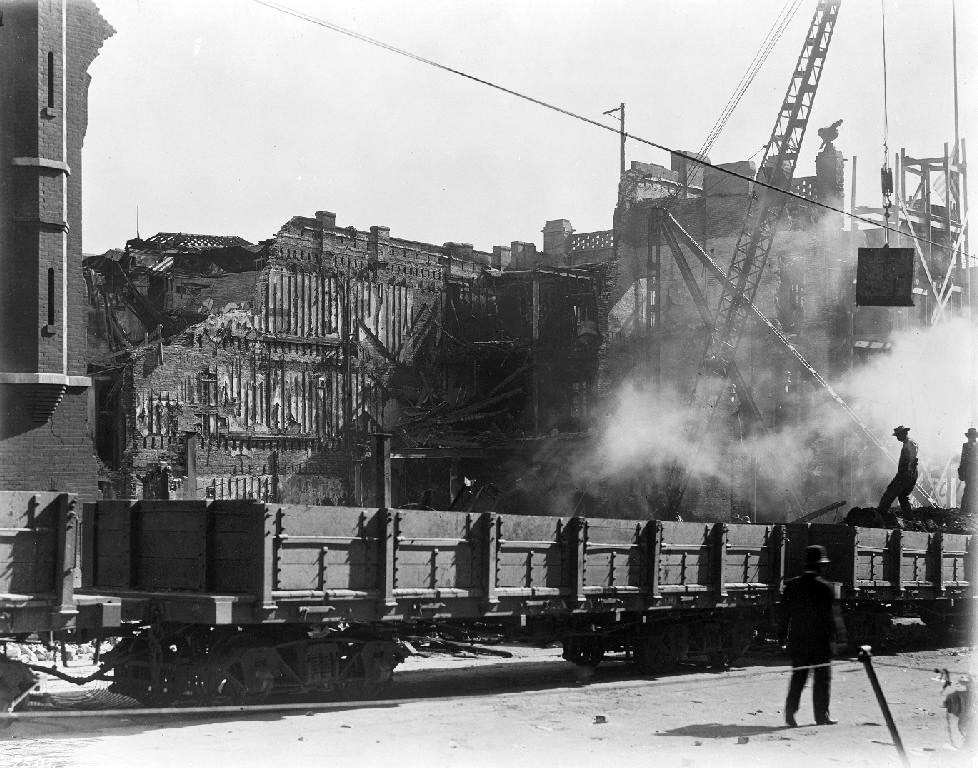The McNamara Bombers in Los Angeles, 1910
By Raphael F. Long
Above is a post card which was published in 1907. It is a colorized version of a photograph taken from the tower of the County Court House located on the southeast corner of Temple and Broadway. On the right is Broadway and the left, barely visible, is Spring Street. First is the cross street and that’s the Nadeau Hotel on the southwest corner of First and Spring. After 1935, that would become the site of the fourth LA Times building.
Spring Street, prior to 1925, extended from First and Spring to Temple and Main. (That’s a gross simplification) The buildings to the left in the image faced on Old Spring Street.
When New City Hall was constructed in 1925, it occupied the former Spring Street dogleg and New Spring Street became parallel to Broadway. There was an alley separating the building labeled “The Times Mirror Printing and Binding House” from the main Times building on the northeast corner of First and Broadway.
It was here where James B. McNamara placed 16 sticks of dynamite on October 1, 1910. He had a timer set to go off at 4:00 AM when the building would be empty. The mechanism failed and went off at 1:07 AM when the building was full of people. McNamara didn’t know there were natural gas trunk lines under the building which exploded in the conflagration along with barrels of very flammable ink. The result was 21 people
burned to death and 121 more injured.
On Christmas Day 1910, John J. McNamara, James’ brother, dynamited the Llewellyn Iron Works adjacent to Capitol Milling. In a very convoluted story, both James and his brother were tracked down and convicted of the crimes. James got life in Folsom and John 15 years. The trial destroyed the career of Clarence Darrow who was forced to plead the brothers guilty in order to save them from the gallows.
In the aftermath, Los Angeles Railway was drafted to haul away the debris from the disaster. The above photo shows flat cars being loaded on Broadway immediately north of First Street. One of those cars survives today at Orange Empire Railway Museum. Note the brass eagle on the roof of the structure. It survives today in the lobby of the new building.
Raphael F. Long
10-22-2013





Nice photos and synopsis of that tragic event . Thank you.
A little off topic, but I’ll put this forth anyway. Sometime after this dynamiting event (but not connected with it), the LA Times strenuously opposed the Pacific Electric plan to continue their elevated trackage from the Main Street Station all the way to the LA river. PE would have then traveled along the east bank of the river to their Aliso Street trackage where PE would have rejoined their existing routes on their Northern District. This would have eliminated the tedious and slow movement through the downtown LA streets for PE and could have cut off 10 to 15 minutes from their runs. This matter was put before the voters, but the LA Times opposition resulted in the failure of this proposition, with the end result that LA lost an opportunity to significantly improve its transit. The rationale for the LA Times opposition was their stated dislike for the noisy and unsightly elevated railroads in Chicago and New York City. Had this proposition passed, we still might be using a direct descendant of the PE, and we might have avoided many of our transit difficulties.
Even though we subscribe to LA Times (and my wife worked for the parent company back in the 1980s and I delivered it in the 60s) torpedoing the elevated connection between 6th & Main and Macy St. Yard is a black mark against the Times that LA rail enthusiasts have trouble forgiving. The reality of extending the 6th & Main elevated terminal tracks to the LA River is that it would have gone through mostly industrial areas, not like the Chicago and NY els going through commercial and residential zones. I would guess that the main consideration had more to do with the financial interests of the Chandlers and their associates than with urban aesthetic considerations.
There’s a big irony in this. It was a Southern Pacific legal case that got corporations the protections of an individual, without the full accountability (just try to extend capitol punishment to a paper entity). Newspapers became corporations, fully protected to make vast sums all under the guarantees of free speech that were meant for living entities. Pacific Electrics troubles and political woes made good copy and increased circulation without the newspapers paying one red cent. Increased circulation paid the printing costs, and all that aggregated advertising for automobile stuff made for profits. Department store advertising revenues went up along with housing tracts. Southern Pacific got revenues from carrying autos too. PE probably carried some of those news stacks to outlying towns. Then the bubble burst. No streetcars to bring people to downtown stores. Autos & trucks blocking rail lines, slowing rail shipments, forcing shippers into trucking. Shopping malls proved that a giant parking lot and truck deliveries would work…then the big box store came into play based on that formula. Department stores dive….no more big ads. Newspapers dive…declining revenues followed with new alternatives for readers. But there’s no end to it all. Companies used to be abandoned and corporate charters simply expired. But now, they carve up every little piece for re-use (name licensing, re-branding, etc.) including the corporate shell (basically a name protected by laws..see that case above). It’s hard to tell if this is sweet revenge or just out-and-out insanity caught in a revolving door of an empty department store converted to lawyers’ housing! Self-driving electric cars that come to your door and deliver you to where? The home improvement store so you can remodel that empty garage and have another bedroom for whom? Next!!